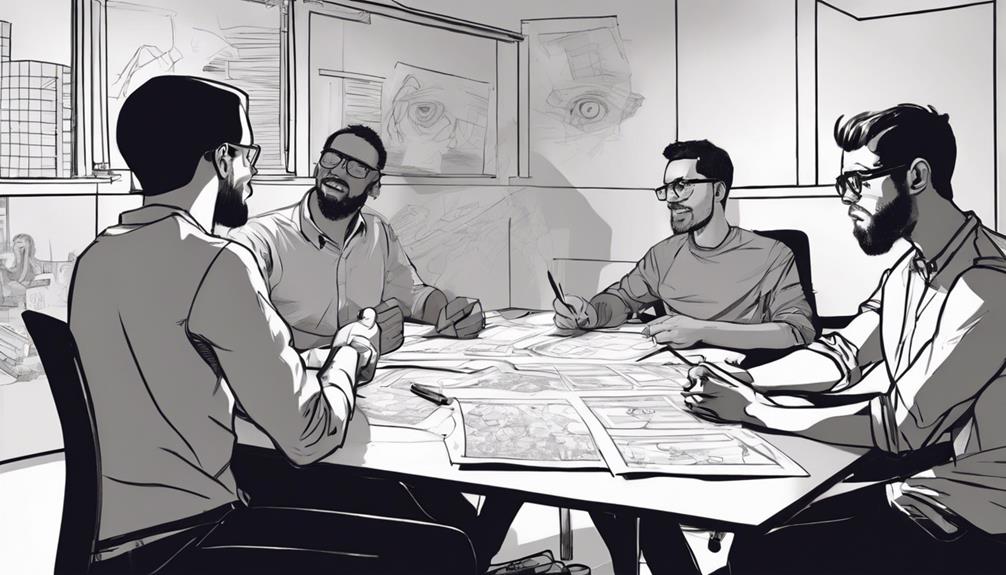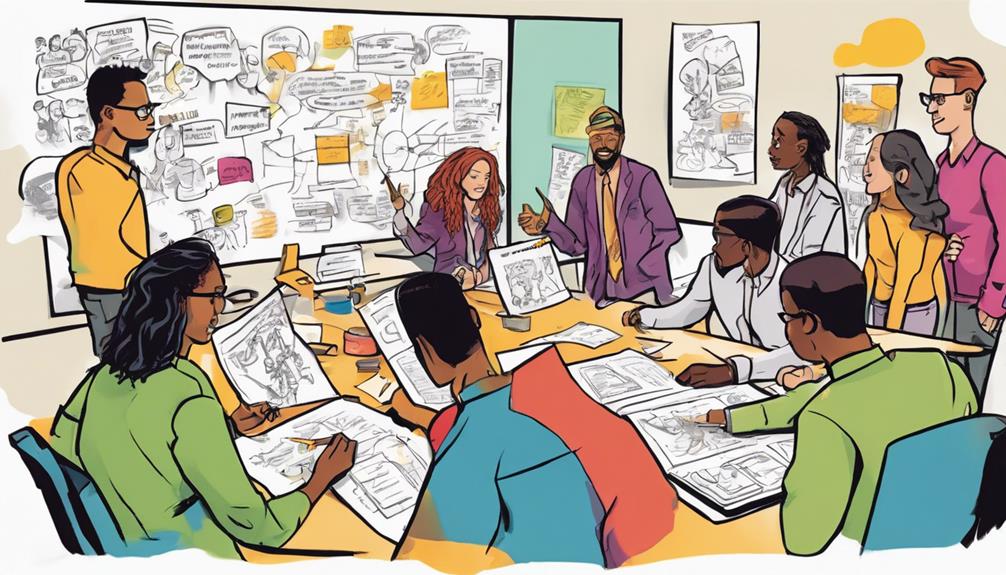In the design thinking process, you form a problem statement during the Define stage. This helps set the stage for addressing user needs effectively and guiding your team towards focused solutions. Crafting a clear problem statement is key as it shapes the foundation for a successful design journey. By defining the problem early on, you guarantee that subsequent stages are driven by a solid understanding of what users truly require. This pivotal step kickstarts your design project on the right track. Further insights await on the techniques and impact of problem statements in the design process.
Key Takeaways
- Problem statements are typically formed in the Define stage of the Design Thinking process.
- They guide the design team in understanding user needs.
- Insights from user research help in crafting effective problem statements.
- Problem statements set the direction for focused solutions.
- Stakeholder validation ensures alignment in defining the problem statement.
Define Stage Importance
In the Define stage of the Design Thinking process, crafting a problem statement is essential for setting a clear direction for solving the user's needs. The problem statement plays a pivotal role in articulating the specific issue that the design team aims to address.
By clearly defining the problem, you guarantee that the solutions generated are focused on meeting the user's needs effectively. Without a clear problem statement, the design process can become unfocused, leading to ineffective solutions that don't truly address the user's requirements.
Defining the problem at this stage is key to ensuring that the subsequent stages of the Design Thinking process are guided by a solid understanding of the user's needs. Thus, creating a clear problem statement in the Define stage sets the foundation for a successful user experience (UX) design process.
Crafting a Problem Statement

Craft a clear problem statement during the Define stage to pinpoint the key issues derived from user research findings, guiding your design process towards addressing user needs effectively.
When crafting a problem statement in the Design Thinking process, consider the following:
- Synthesizing User Research: Combine insights from user research to identify the most critical problems.
- Focusing on User Needs: Guarantee that the problem statement revolves around addressing the specific needs of the users.
- Guiding the Design Process: Use the problem statement as a compass to steer your design project in the right direction.
- Developing Targeted Solutions: A well-crafted problem statement leads to precise and effective solutions.
Crafting a problem statement is a pivotal step in the Design Thinking process as it sets the foundation for the design project.
Techniques for Problem Development

Utilize techniques such as space saturation, empathy mapping, and Point of View statements to effectively develop and articulate meaningful problem statements in design thinking. When defining problem statements, employing methods like How Might We questions and Why-How Laddering can aid in problem identification and solution generation. Problem statements should be action-oriented, starting with a verb to focus on solutions. By utilizing space saturation and empathy mapping, you can better understand user needs and define a problem that resonates with them. Additionally, crafting Point of View statements helps in framing the user's needs and insights in a more actionable way.
| Techniques | Description | Example |
|---|---|---|
| Space Saturation | Immersing oneself in the environment to gather insights and understand the context of the problem. | Conducting interviews and observations on-site. |
| Empathy Mapping | Creating visual representations to empathize with users, understand their behaviors, thoughts, and emotions. | Drawing a map detailing a user's feelings. |
| Point of View | Crafting statements that capture a user's needs and insights to guide problem-solving from the user's perspective. | "Sarah needs a way to track her daily tasks." |
Impact of Problem Statements

You need to understand how problem statements can greatly influence the success of your design projects.
Crafting effective problem statements guarantees that you address the core issues at hand and create user-centric solutions.
Problem Statement Importance
Problem statements play an important role in design thinking by guiding the focus of the project towards understanding user needs and defining the project's scope. They're vital in the design process as they help to define the user problem clearly and identify the root cause that needs to be addressed.
An actionable problem statement sets the stage for developing potential solutions that are innovative and user-centered. Empathy matters greatly in this process, as problem statements that truly resonate with users lead to effective solutions.
Here's why problem statements are of utmost significance in design thinking:
- Guiding the Design Process: Problem statements ensure that the project stays focused on user needs.
- Defining the Scope: They help in clearly delineating the boundaries of the project.
- Root Cause Identification: Problem statements address the underlying issues, not just the symptoms.
- Encouraging Innovation: Well-crafted problem statements inspire creativity in finding solutions.
Problem Statement Development
Developing impactful issue statements is pivotal in design thinking as they guide the project towards addressing the root cause of user needs and fostering innovation in finding user-centered solutions.
In the Define stage of the design thinking process, a good issue statement is typically formed. Key steps in this process involve asking 'How might we' questions to frame your issue effectively.
By identifying themes and patterns from user insights, you can craft an issue statement that needs to be solved. This statement sets the boundaries for the project and helps prioritize resources efficiently.
Validating the issue statement with stakeholders ensures alignment and understanding of the project scope, leading to a final design that's focused on addressing the core user issues.
Effective issue statement development is essential for driving the design process towards creating impactful and meaningful solutions that truly meet user needs.
Next Steps After Defining

Now that you have defined the problem statement, it's time to shift gears towards the solution ideation process. This phase involves brainstorming and generating potential solutions that align with the identified needs.
Solution Ideation Process
During the solution ideation process in Design Thinking, your team collaborates to generate a wide range of creative ideas for potential solutions. It's a phase where brainstorming is essential, and thinking creatively from diverse perspectives is encouraged to develop innovative solutions.
Here are some key aspects of the solution ideation process:
- Brainstorming Creative Ideas: Engage in free-flowing idea generation sessions without judgment.
- Aligning with User Needs: Constantly refer back to the problem statement to guarantee solutions meet user requirements.
- Collaborative and Diverse Perspectives: Encourage team members to contribute ideas from different backgrounds and experiences.
- Developing Prototypes and Testing: Use the ideated solutions to create prototypes for testing with users, gathering feedback, and iteratively improving the designs.
The ideation phase sets the foundation for creating effective solutions that address the identified problem statement through innovative and user-centered approaches.
Defining Clear Objectives
Defining clear aims in the Design Thinking process sets a focused direction for your design project, guiding subsequent stages towards successful outcomes. Once you have defined the problem statement, the next essential step is to establish clear aims by setting specific goals for your design project.
These aims will guide the ideation, prototyping, and testing phases, ensuring that your work is always aligned with the project goals. By constantly referring back to the initial problem statement, you can maintain this alignment throughout the design process.
Clear aims are crucial for creating user-friendly solutions that effectively address the defined problem. They provide a roadmap for your design project, helping you stay on track and focused on achieving the desired outcomes. Remember, well-defined aims not only shape your project but also influence the quality and success of the final product.
Design Thinking Process Overview

In the Design Thinking process, you embark on a journey that centers around understanding user needs and creating innovative solutions. This methodology follows a structured approach to problem-solving, emphasizing empathy and creativity throughout the design process.
Here's a brief overview to guide you through the stages:
- Empathize Stage: Begin by grasping the user's perspective and needs.
- Define Stage: Synthesize the collected data to outline the user problem and formulate a problem statement.
- Ideate Stage: Brainstorm and generate creative solutions to tackle the outlined problem.
- Prototype Stage: Develop tangible representations of your ideas to test and gather feedback from users.
This iterative process ensures a user-centered approach, where the problem statement plays an essential role in guiding the design team towards creating innovative solutions that effectively address user needs with a focused approach.
Frequently Asked Questions
During Which Stage of the Design Process Is a Problem Statement Formed?
In the design process, a problem statement is formed during the Define stage. This pivotal step follows Empathize and involves synthesizing data to clearly define the user problem. Crafting a meaningful problem statement guides creating user-centered solutions effectively.
At Which Stage Is the Problem Statement Made?
In the Design Thinking process, the problem statement is crafted during the 'Define' stage. It's the pivotal point where you shape the direction and focus of your design journey by articulating user needs.
What Is the Problem Statement in Design Thinking Process?
In design thinking process, the problem statement is a concise articulation of the user problem that guides the design process by focusing on user needs and setting clear boundaries. It guarantees effective problem-solving.
What Are the 4 Stages in the Design Problem-Solving Process?
In the design problem-solving process, you start on a journey through Empathize, Define, Ideate, and Prototype/Test stages. Each step propels you closer to crafting innovative solutions by understanding, defining, brainstorming, and testing.
Conclusion
To summarize, forming a problem statement in the design thinking process is essential for guiding the design process and ensuring solutions meet user needs.
Just like a compass points north in a vast sea, a well-crafted problem statement serves as a guiding light in the design journey, helping teams navigate through challenges and towards innovative solutions.
So, remember to always start with a clear problem statement to set the course for success.









